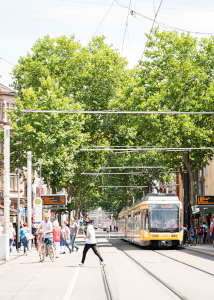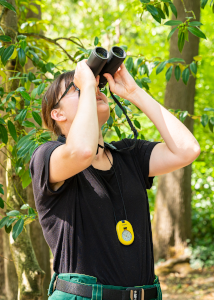Ecosystem services of urban trees and forests
Why measuring the services of urban trees is so important

Trees along roads and footpaths, in avenues, parks, gardens and urban forests in urban and rural areas reduce environmental pollution, clean the air and water, reduce heat stress and bind CO2. With their ecosystem services, they thereby increase resilience to climate impacts and are of great importance to people as well as nature. Green spaces in urban and rural areas are therefore often referred to as "green lungs." However, although they play an important role in urban adaptation, urban forests are themselves vulnerable to climate change. Moreover, trade-offs may occur between different ecosystem services (e.g., cultural services vs. regulating services). To assess and possibly resolve these, a quantitative and qualitative assessment of ecosystem services (or valuation) is needed.
How we can measure ecosystem services...
In preparation for our measurements, a grid was first laid over the entire study area on the computer and divided into smaller sub-areas. Within these sub-areas, two points (the later study areas) were randomly determined. In a radius of 11.34 m around each of these points, the entire vegetation was finally recorded. Trees were examined in particular detail, because not only their relative position in relation to the center point was recorded, but also various tree characteristics such as tree species, height, trunk diameter, crown expansion, crown thinning and much more. Lastly, microhabitats (microhabitats) were additionally recorded for trees with trunk diameters greater than 20 cm.
The measurement campaign was used to calculate and analyze the ecosystem services provided by urban trees and forests. This was intended to improve both the perception for the benefits of ecosystem services (ES). By evaluating ecosystem services, the appreciation for trees should increase and justify the high effort for maintenance and care in the long term. In addition, it was investigated whether there are conflicting goals between individual services provided by urban trees.

... and how we evaluated the urban tree health
How healthy are the trees in and around Karlsruhe? Does one tree species have a particularly hard time? Or is there something like location-dependent health patterns in the trees? To answer these and other questions, in addition to the above-mentioned parameters, tree physiological studies were also carried out on trees in urban green spaces, private areas (e.g. gardens) and forests close to the city in Karlsruhe and Rheinstetten. For this purpose, we examined health indicators on the trunk, branches, and leaves of the tree, such as water veins, wounds, dead and severed branches, and discolored or wilted leaves. The first goal here was to better understand the behavior and response of trees to the urban environment and drought. And based on this, to get a better overview of the city-wide tree population and its health to better assess the ecosystem services provided by the trees.
23 ecosystem services could be measured
In total, we were able to calculate 23 ecosystem services in the GrüneLunge 1.0 project and found out that a higher provision of ecosystem services takes place in forest and near-natural areas. The calculated ecosystem services are an important basis for the adaptation of management plans in urban areas and serve to increase the valorization of urban green spaces.
The results of the evaluation will be used in the future to develop a point-based evaluation system for ecosystem services of urban trees. This should enable the valorization of ecosystem services in management plans and a close cooperation with the city of Karlsruhe is intended. In addition, locations were identified where conflicting goals between ecosystem services arise. This identification will be taken into account in future urban planning in order to reduce conflicting goals and to promote the potential provision of ecosystem services of urban green space.
How vulnerable our trees are
In recent years, research in the GrüneLunge 1.0 project has shown that prolonged periods of heat and lack of precipitation in particular have led to a decline in the health of urban trees. Currently, only about 6% of the urban trees in Karlsruhe can be classified as healthy.
The results of the tree health analysis will be used to develop strategies to improve the health of the tree species most affected by stress factors (e.g. drought, heat stress, insect infestation). Otherwise, the identification of health problems will be used to provide alternative futures for the affected tree species, such as irrigation, replanting, changing tree species composition in certain locations.
.png)
